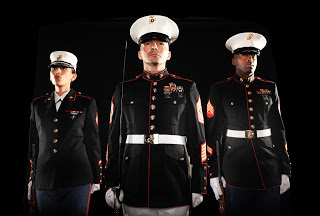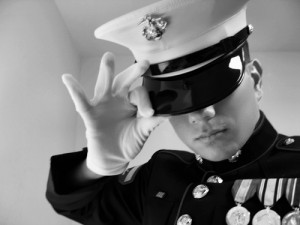The Marine Corps Dress Blues: Myth vs. Truth
When most Americans think of the United States Marine Corps, they think of a well-established institution, a pillar of American power and national security. And it is. But at points in its history, the Marines have had to fight for their very survival—and I’m not talking about the battlefield. The history of the Marine Corps’ fight for legitimacy is captured in its most famous symbol: the iconic Marine Corps Dress Blue uniform.
Fighting for Survival
In the immediate aftermath of World War I, the Marines found themselves in an odd and uncomfortable position. Their mission had become ambiguous, and they feared for their future in the face of post-war demobilization. In response, the Marines launched a public relations campaign to redefine themselves as the nation’s premier expeditionary force capable of rapidly deploying to coastlines throughout the globe.
As part of the marketing effort to redefine the Marines’ mission, Major General John Lejeune, Marine Corps Commandant from 1920 to 1929, began a campaign to boost the service’s esprit de corps. The Marine Corps Dress Blue uniform became a centerpiece of his effort. Lejeune used a combination of historical facts and mystique to create the legend of the Dress Blues that would help bolster the reputation of the Marine Corps and cement its permanent place in the branches of the U.S. armed forces. Over time, that legend has been entwined so closely into the story of what it means to be a Marine that it’s become difficult to separate fact from fiction. But we’re going to try.
Leathernecks are Born
Most famously, perhaps, is the legend behind the Dress Blues’ standing collar. As the story goes, the standing collar was designed as a protection against sword strikes to the neck in the often vicious hand-to-hand fighting that ensued during ship boarding in the 18th century. These original collars were made of leather, hence the term “leatherneck.”
 The more likely truth is that the high collars were designed to ensure that Marines kept their heads up straight and tall. That’s a far cry from sword strikes, but sword strikes sound a whole lot tougher and more “Marine.” Over time, the Marine Corps adapted the high leather collar, changing it from leather to a rigid cloth, and making it just a little bit wider and more comfortable.
The more likely truth is that the high collars were designed to ensure that Marines kept their heads up straight and tall. That’s a far cry from sword strikes, but sword strikes sound a whole lot tougher and more “Marine.” Over time, the Marine Corps adapted the high leather collar, changing it from leather to a rigid cloth, and making it just a little bit wider and more comfortable.
Blood Stripes
One of the most noticeable elements of the Marine Corps Dress Blues is the red stripe running down the outer edge of their dark blue trousers. The width of the stripe increases by rank (1 1/8 ” for NCO and SNCO, 1 ½” for officers up to Colonel, and 2” for Generals). The width is supposed to represent the level of service, or blood, the soldier has put in the corps.

According to the Marine Corps website, this red “blood stripe” worn by NCOs and officers is in memory of “those Marines who died in the Battle of Chapultepec during the Mexican War in 1847. Today, the blood stripe honors the memory of all our fallen comrades.”
The real reason for the red stripe is more prosaic, however. In the early 1800s, the uniform regulations required that the trouser stripe match jacket facings. For Marines of that time period, the facings were red, so the stripe was changed to red, as well. Over time, the red facing was changed, but the stripe remained.
The Quatrefoil
Another recognizable feature of the Marine Corps Dress Blues is the white service cap. Officers have a four-figured shape, known as a quatrefoil, embroidered on the top of the dress and service caps. Tradition holds that the quatrefoil was adopted to distinguish Marine officers from the enemy, ensuring that sharpshooters on the boarding vessel wouldn’t shoot their own.
This story, too, is diffi cult to corroborate. The quatrefoil was a popular design element of the time and was likely adopted more for aesthetic purposes. This theory is supported by the Marine Corps League, which states that the Marines’ quatrefoil design was influenced by Napoleon III.
cult to corroborate. The quatrefoil was a popular design element of the time and was likely adopted more for aesthetic purposes. This theory is supported by the Marine Corps League, which states that the Marines’ quatrefoil design was influenced by Napoleon III.
The Myth, The Marine
 More so than the other service branches, the Marine Corps prides itself on its strong and noble history, tradition, and mythology. And part of being a Marine means aligning yourself with that history—becoming part of a living legend. For historians, the mystique can make it difficult to tease out the truth from the hyperbole. But to me, anyway, I’m not sure it matters. In the end, whether blood stripes stemmed from honoring falling comrades of the Mexican War, or whether that story was added on later, does not detract from the long history of honor, courage, and patriotism that makes a Marine a Marine.
More so than the other service branches, the Marine Corps prides itself on its strong and noble history, tradition, and mythology. And part of being a Marine means aligning yourself with that history—becoming part of a living legend. For historians, the mystique can make it difficult to tease out the truth from the hyperbole. But to me, anyway, I’m not sure it matters. In the end, whether blood stripes stemmed from honoring falling comrades of the Mexican War, or whether that story was added on later, does not detract from the long history of honor, courage, and patriotism that makes a Marine a Marine.
